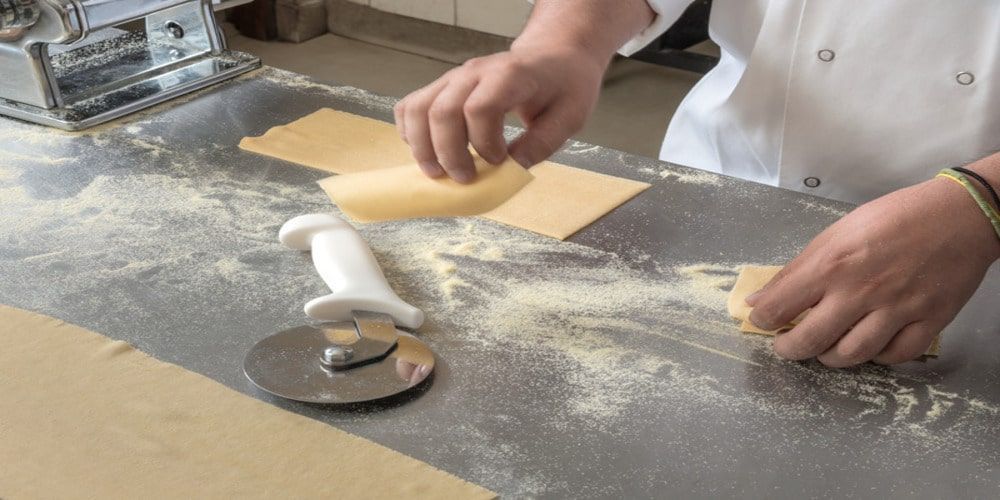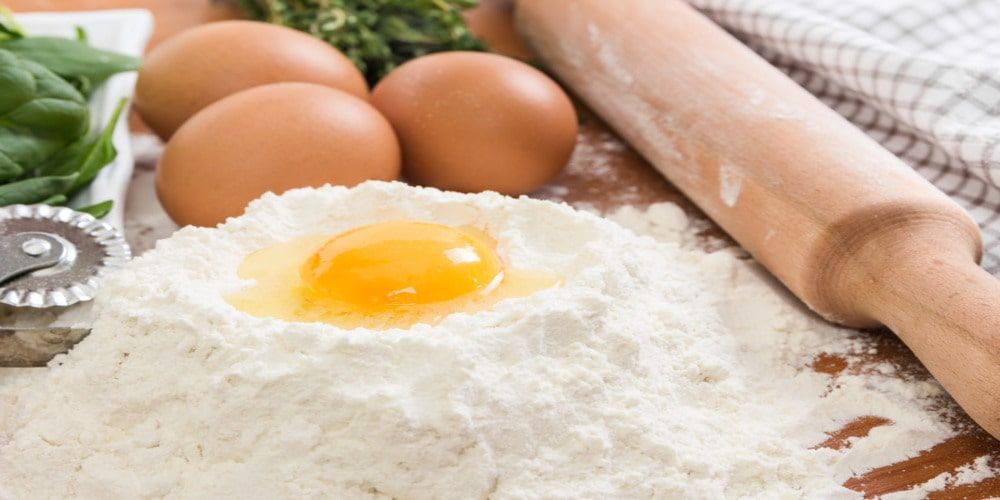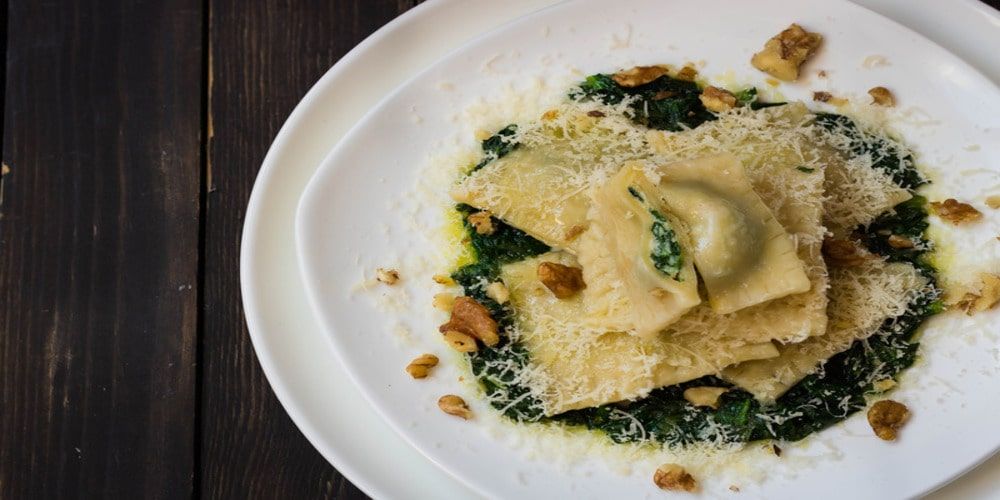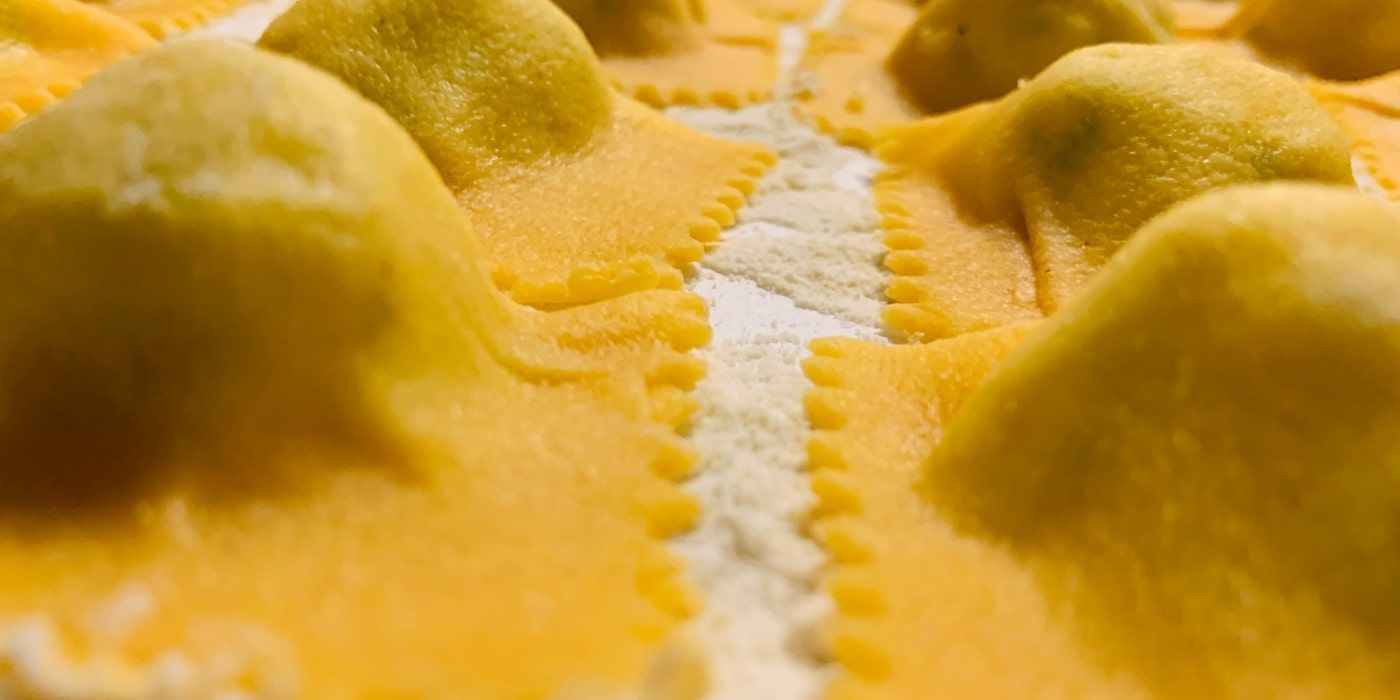When we remember our childhood dishes, we cannot help but think of egg pasta, back to the time when our grannies used to prepare it strictly by hand, to the long stretches of yellow dough over which the rolling-pin ran quickly, to the flour that flooded the worktable and to its embracing scents.
What we mean is that egg pasta is not only the basis of delicious and sophisticated dishes, that testify to the manual skill of those who prepare them, but also an unbreakable link to our family traditions.
And although there are many variations of it in all regions of Italy, the area that perhaps most takes up this specialty is Emilia-Romagna, where handmade pasta is the star of most typical recipes. Among these, we cannot fail to mention ravioli, a rich and hearty but above all extremely versatile format of fresh egg pasta. Yes, because although the classic filling is made of ricotta cheese and spinach, it is possible to make many different variations of it, depending on one's taste.
This is a long and intricate recipe, which certainly requires a lot of attention and dexterity, but it can provide great satisfaction.
Find out with us how to cook homemade ravioli as our grannies did and the origins of this fabulous stuffed pasta, which we'll fill with the aforementioned winning ricotta-spinach combo.

Homemade ravioli: origins

Sfoglines making egg past sheets
We do not know precisely what the origins of homemade ravioli are, but it is thought that a "prototype" of them was already being cooked in the Middle Ages, if not even in Ancient Rome. In fact, it seems that the cook and gastronome Marcus Gavio Apicius, thanks to whom we know many details of Roman cuisine, prepared a kind of dumpling that closely resembled stuffed pasta and that he called it “Apicius' pie”.
Probably, however, a version very similar to the one known today appeared in about 1200 in Gavi Ligure, where a cook named Ravioli created delicious stuffed caskets and gave them the famous rectangular zigzag-edged shape. Later, the format was exported to Emilia-Romagna, which made it a highlight of its gastronomy.
Ravioli's deliciousness was even praised by the great Boccaccio, who in his Decameron, in the novella of the eighth day, wrote "...stava genti che niuna altra cosa farevan che far maccheroni e ravioli e cuocarli in brodo di capponi...," depicting the delights of the Land of Bengodi.
Today, ravioli take different shapes, fillings and names depending on the region and province where they are prepared; here are a few examples:
• Agnolotti in Piedmont, stuffed with meat or meat and vegetables;
• Pansoti in Liguria, with various herbs;
• Casonsei in Lombardy, with meat, macaroons and raisins;
• Tordelli in Tuscany, with meat, chard and cheese;
• Ravaiuolo in Irpinia, with ricotta, eggs and parsley.
Finally, since we will focus on the typical ravioli of Emilia-Romagna, we cannot fail to mention the mythological figure of the sfoglina.
The sfoglina is the guardian and heir to the art of handmade egg pasta in the region, and particularly in Bologna, an actual institution that still survives today thanks to a willingness to pass this skill down from mother to daughter – and that is practiced strictly with a rolling-pin.
Today in Bologna you will find several handmade pasta factories where you can buy fresh egg varieties, created by the skilled hands of the sfoglines or you can enjoy it in taverns and in the city center – and that's a mystical experience not to be missed.
Ingredients for 4 servings

Ingredients for homemade ravioli
For the dough:
400 g of 00 flour
4 eggs
Salt to taste
For the filling:
250 g spinach
200 g drained cow's ricotta
Parmesan cheese to taste
Pepper and salt to taste
Olive oil to taste
For the dressing:
100 g butter or margarine
Fresh sage leaves to taste
Parmesan or pecorino cheese to taste
Ps. For this recipe, we recommend you to arm yourself with some tools, such as a rolling-pin, a sac à poche, a (possibly fluted) wheel- cutter and, if necessary, a hand-crank machine.
Use a wooden or silicone pastry board or surface as a base; form a fountain with flour and create a hollow in the center.
Add some salt along the perimeter and all the eggs in the center, one by one. Start mixing with a fork and later with your hands and then knead with your hands until the flour is absorbed.
Continue kneading for several minutes, crushing and pushing the dough forward with the lower part of the back of your hand. Occasionally add flour to the work surface to keep the dough from sticking.
After about 10 minutes of kneading, create a ball with the dough, cover it with plastic wrap or a towel and let it rest for half an hour.
Meanwhile, deal with the filling. Put some olive oil and a clove of garlic in a pan; let it sizzle and then remove it. Add the spinach, salt and let it cook for about 10 minutes.
When the spinach is ready, pour it into a high-sided bowl, add ricotta cheese and Parmesan and season with salt and pepper. Stir to combine the ingredients and let cool a few minutes.
Take the dough again and cut it in half; sprinkle some flour on the pastry board and flatten the first loaf with the backs of your hands until it forms a disk. Then start rolling it out with a rolling-pin. Do the same with the second one. You'll have two large and long pasta sheets.
The trick to obtain a flawless egg pasta sheet is to roll it out from the center, running the rolling-pin in all directions. Keep rolling until you have reached your preferred thickness.
Grandma's or sfoglina's method claims the only usage of a rolling-pin for rolling out the dough, but if you want it to be really thin and uniform you can also use the hand-crank machine. Run the floured pastry sheet through the machine several times, turning the crank and gradually decreasing the thickness of the gears, or at least until the dough becomes thin but not excessively so, otherwise it might break (tradition says you have to pass it about ten times, but we recommend doing it to your own taste). Do the same with the other half.
Now you should prepare the water for cooking the pasta, so take a tall pot, fill it and place it on the stove.
When you are satisfied with your egg pasta sheets, take the bowl with the filling and with the help of a spoon or a sac à poche place small balls on the pastry sheet about 3-4 centimeters from each other, taking care to leave a starting and ending margin of a couple of centimeters.
Once the dough is completed, moisten the edges of the pastry sheet with water, take the other half of the sheet and place it on top of the one with the filling so that it completely covers it. Press lightly along sides and corners in order to stick the two sheets of dough together.
Now you can finally make your own homemade ravioli! With a knife, or better yet, fluted a wheel-cutter, cut rectangles or squares of dough so that the filling is perfectly in the center of the dumplings you will create.
Your ravioli are ready: time to plunge them into the boiling water! Like all types of fresh pasta, cooking is very quick - it will take only a couple of minutes. Watch out for the dumplings rising to the surface, because that means they are ready to be drained.
While waiting, prepare the sauce: you will need a pan in which you will melt butter or margarine and add fresh sage leaves. When the ravioli have risen to the surface, you will just drain them in a colander and pour them into the hot pan or, even better, take them with a skimmer and pour them directly into the pan. This way you will bring a few drops of cooking water into the pan, which will help you to make the sauce creamier.
Sauté for a couple of minutes and add plenty of grated parmesan or pecorino cheese and serve immediately.
Buon appetito!
Homemade ravioli: variations and suggestions

A dish of homemade spinach and ricotta ravioli
Egg pasta is a hymn to creativity, so now that you know how to cook homemade ravioli you can explore all the possible ways regarding shape, filling and topping.
Here we give you some ideas:
• Shape: as we have already mentioned, each region and province has its own variation, and in addition to the classic square or rectangular shape you will also find different ways of closing it depending on the area where you taste it. In fact, you will often be able to taste them round, half-moon shaped, like a candy or a tiny pouch. In some restaurants you will even find colorful dumplings, because a coloring element is added to the dough, such as spinach, beet or squid ink.
• Stuffing: we used the classic with ricotta and spinach, but for similarly vegetarian fillings we suggest pumpkin and parmesan, cheese and herbs, porcini mushrooms, but also eggplant and tomato or potato and mint, perhaps with some grated lemon zest to add extra freshness. Eventually you can opt for the classic filling of ground meat, mortadella or prosciutto, or for a tasty seafood variant, with salmon and chives, sea bass or swordfish. In general, stuffing for homemade ravioli can be a great leftover recipe.
• Seasoning: the filling naturally determines the seasoning of our ravioli. For the ricotta and spinach version, the most commonly used is the butter-and-sage one, to be heated for a few minutes in a pan, which actually goes well with most of the fillings we have suggested. Alternatively, you can make a light tomato and basil sauce and add a final sprinkling of Parmesan cheese, or, if you want something more intense, a four-cheese cream with a pinch of pepper. For pumpkin ravioli, a very sophisticated combination involves a crumble of Amaretti cookies, which contrast with the sweetness of the interior; Ligurian pansoti, on the other hand, are presented with the traditional walnut cream – an actual delicacy. In general, we would suggest you to keep in mind that the filling is already rich in itself, so it is up to you to choose a light topping, by contrast, or if you want to create a dish with multiple flavors and aromas.
So, put your hands together and make your own personalized egg pasta masterpiece.
About the author
Written on 09/06/2023



Denise Penna
Want to learn how to cook homemade ravioli like grandma? Here some tips for preparing them according to Emilia-Romagna tradition.